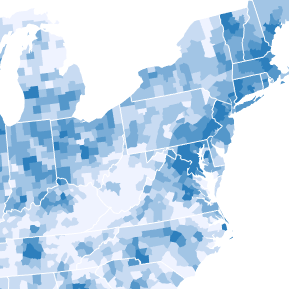Where Participation Points Matter: Labor Force Participation Rates in US Counties

By Patrick Clapp |
-
Labor Force Participation Rate and Size (civilian population 16 years and over)
-
< 53.0%
-
53.0% to 58.0%
-
58.0% to 62.0%
-
62.0% to 65.0%
-
65.0% to 68.0%
-
≥ 68.0%
In Eagle County, Colorado, 80% of the civilian population 16 or older were either working or looking for work in 2015. In Sumpter County, Florida, that figure was below 25%.
An active working-age population is a critical component to support economic growth, and the labor force participation rate—calculated as the percentage of the civilian population 16 years and older who have a job or are looking for one—provides a helpful measure of this activity and the health of a region’s economy.
The national labor force participation rate was 63.3% in 2015, but participation rates vary widely by county. The top 10 counties[1] with the highest labor force participation rates (and populations greater than 10,000) are detailed in the table below. Many of the top counties benefitted from growth in bordering counties due to the oil and gas boom occurring during the survey years (2011-2015) or are bedroom communities for commuters working in nearby metro centers experiencing growth (such as Washington, D.C.) and tourist attractions.
| County with Population Greater than 10,000 | Labor Force Participation Rate 2015 | ||||
|---|---|---|---|---|---|
| Eagle County, Colorado | 80.0% | ||||
| Teton County, Wyoming | 78.6% | ||||
| Summit County, Colorado | 77.9% | ||||
| Alexandria City, Virginia | 77.7% | ||||
| Lincoln County, South Dakota | 77.4% | ||||
| Arlington County, Virginia | 77.3% | ||||
| Scott County, Minnesota | 76.7% | ||||
| Campbell County, Wyoming | 76.6% | ||||
| Teton County, Idaho | 76.5% | ||||
| Carver County, Minnesota | 76.1% | ||||
| Source: JobsEQ®, ACS 2011-2015 | |||||
The national unemployment rate of 4.4% in September 2017 suggests full employment. At the same time, some regions continue to struggle to recover from the Great Recession based on their low participation rates.
The participation rate provides a measure of the population willing to work as well as groups that have been discouraged from participating or are unwilling to enter the labor force. Increasing participation in the labor market can boost production and economic growth in a region if firms are not producing at full capacity because of labor shortages.
People may not participate in the labor force for a number of reasons, including retirement, disabilities, taking care of a family member, and attending school. In a previous blog post we discussed the population facing barriers to employment which may discourage them from participating in the labor force. We estimated integrating this group into the labor market could increase the national labor force participation rate by 1.2 percentage points.
Nationally, the labor force participation rate has been declining since 2000, and there is some confusion about why. Some of the change can be explained by the baby boomer population entering retirement as well as more young adults staying in school longer and pursuing higher education. Numerous other explanations exist for the remaining decline, including recently that opioids account for a large share of the drop in labor force participation among men.
However, participation rates are not declining everywhere. Between the 2010 and 2015 estimates, labor force participation rates rose in about 20% of counties. The ten counties with the largest percentage point change in labor force participation between 2010 and 2015 are shown in the table below. Areas at the top of this list tended to have particularly low participation rates in 2010, and often also saw improved educational attainment of the population.
| Labor Force Participation Rate | |||||
|---|---|---|---|---|---|
| County with Population Greater than 10,000 | 2010 | 2015 | Change (Percentage Points) | ||
| Buckingham County, Virginia | 27.4% | 51.4% | 24 | ||
| Goochland County, Virginia | 45.1% | 60.3% | 15.2 | ||
| Powhatan County, Virginia | 47.8% | 59.6% | 11.8 | ||
| Karnes County, Texas | 35.5% | 45.8% | 10.3 | ||
| Summers County, West Virginia | 38.5% | 46.9% | 8.3 | ||
| Limestone County, Texas | 48.1% | 54.8% | 6.6 | ||
| Harrisonburg City, Virginia | 51.8% | 58.3% | 6.5 | ||
| Iron County, Missouri | 46.8% | 52.6% | 5.8 | ||
| Clarke County, Alabama | 44.4% | 50.2% | 5.8 | ||
| Rio Grande County, Colorado | 54.0% | 59.8% | 5.7 | ||
| Source: ACS 2011-2015, ACS 2006-2010 | |||||
[1] Though data in the map are shown for every county, data in the tables are limited to regions with a population of at least 10,000 people to minimize potentially misleading estimates in small counties.
Subscribe to the Weekly Economic Update
Subscribe to the Weekly Economic Update and get news delivered straight to your inbox.